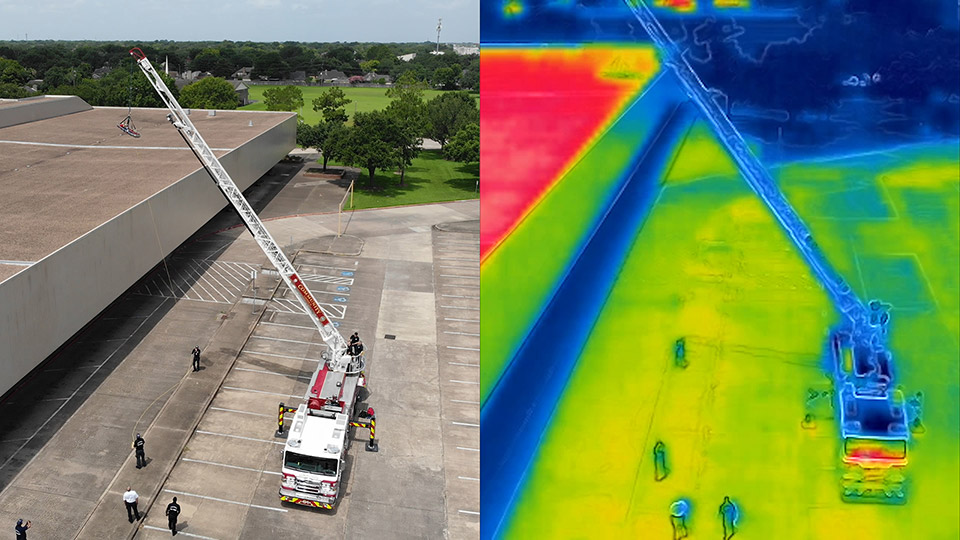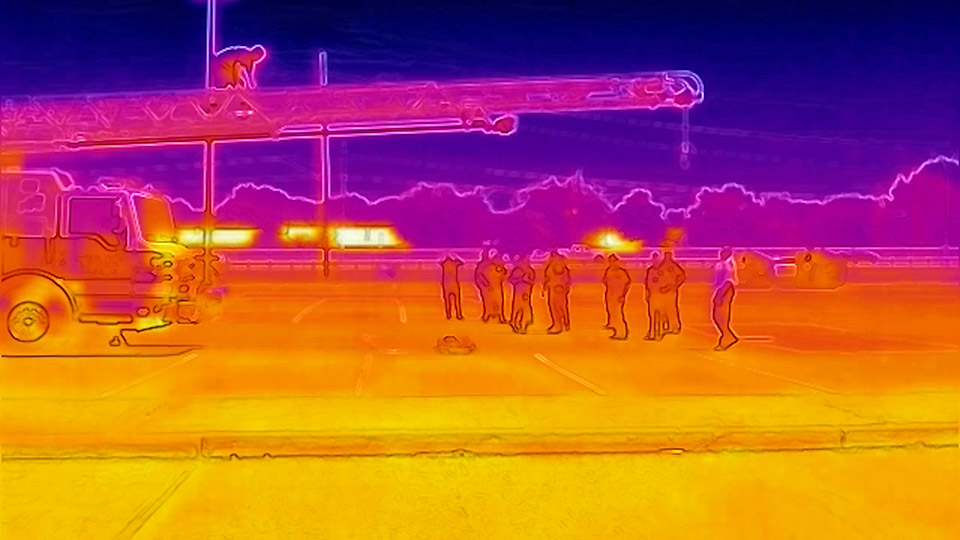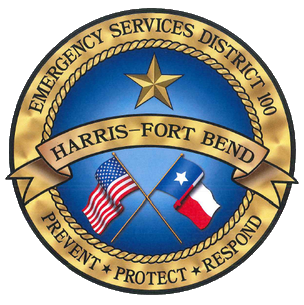Harris Fort Bend ESD #100 is excited to support Community Volunteer Fire Department with their Drone Program.
The drone will contain both visible (normal) and thermal cameras for use in a variety of situations such as:
- Fire conditions and firefighter safety
- Hazardous materials incidents
- Search and rescue
- Locating missing persons
- Natural disasters
Monitoring Fire Conditions
The thermal camera equipped drone will be able to see heat signatures and firefighter locations on scene. The thermal camera is unobstructed by smoke so that it can fly high above the scene and see changes in temperature patterns while crews are hard at work. This information can be used by incident command to adjust the fire attack strategy to most effectively control the incident.
Hazardous Materials Incidents
Often times when crews are first called to a hazardous materials incident, they may not know what the substance in question is or if there are any victims of the incident. A drone allows crews to collect more information on what types of substances are on the scene through placards and signage as well as what types of personal protective equipment are required to safely enter the scene. Hazardous materials incidents are often long incidents which require continuous monitoring of conditions. A drone will allow for high-level visibility and monitoring of the incident from a safe location.
Search & Rescue
Search and rescue incidents can be in locations which are difficult to access to evaluate the scene and make contact with the patient(s). A drone can be used to develop a rescue strategy, determine the resources needed, and establish patient contact and condition. The drone has two-way audio and spotlight capabilities to provide instructions or gather additional information from the victims involved. This can be especially useful for large natural disasters where manpower and paths of travel are obscured.
Locating Missing Persons
Beyond just having a bird’s-eye-view of a large area for searching, the thermal technology is able to be programmed to identify specific temperature ranges. This allows a human body signature to be seen when a visible camera could not – through trees and minor obstructions, at night, etc.

Visible and thermal cameras can be activated at anytime during flight.

The thermal camera is configurable to highlight different temperature ranges depending on the mission at hand.
Harris Fort Bend ESD #100 is excited to introduce a drone program being developed for use by Community Volunteer Fire Department. The submission process is currently in progress with the Federal Aviation Administration (FAA) for flight capabilities beyond that of a typical commercial drone pilot such as flying in restricted airspace, flying at night, and flight over people in certain situations.
The drone will contain both visible (normal) and thermal cameras for use in a variety of situations such as:
- Fire conditions and firefighter safety
- Hazardous materials incidents
- Search and rescue
- Locating missing persons
- Natural disasters
Monitoring Fire Conditions
The thermal camera equipped drone will be able to see heat signatures and firefighter locations on scene. The thermal camera is unobstructed by smoke so that it can fly high above the scene and see changes in temperature patterns while crews are hard at work. This information can be used by incident command to adjust the fire attack strategy to most effectively control the incident.
Hazardous Materials Incidents
Often times when crews are first called to a hazardous materials incident, they may not know what the substance in question is or if there are any victims of the incident. A drone allows crews to collect more information on what types of substances are on the scene through placards and signage as well as what types of personal protective equipment are required to safely enter the scene. Hazardous materials incidents are often long incidents which require continuous monitoring of conditions. A drone will allow for high-level visibility and monitoring of the incident from a safe location.
Search & Rescue
Search and rescue incidents can be in locations which are difficult to access to evaluate the scene and make contact with the patient(s). A drone can be used to develop a rescue strategy, determine the resources needed, and establish patient contact and condition. The drone has two-way audio and spotlight capabilities to provide instructions or gather additional information from the victims involved. This can be especially useful for large natural disasters where manpower and paths of travel are obscured.
Locating Missing Persons
Beyond just having a bird’s-eye-view of a large area for searching, the thermal technology is able to be programmed to identify specific temperature ranges. This allows a human body signature to be seen when a visible camera could not – through trees and minor obstructions, at night, etc.

Visible and thermal cameras can be activated at anytime during flight.

The thermal camera is configurable to highlight different temperature ranges depending on the mission at hand.
